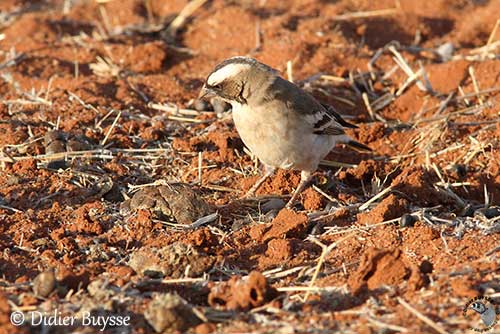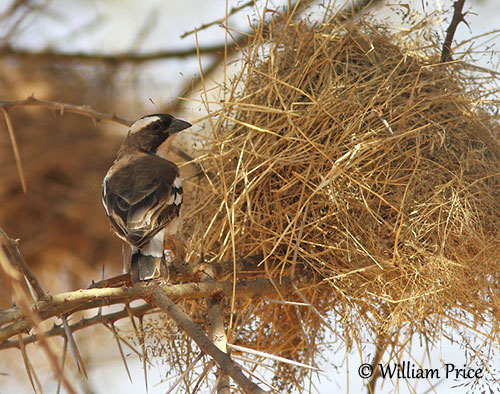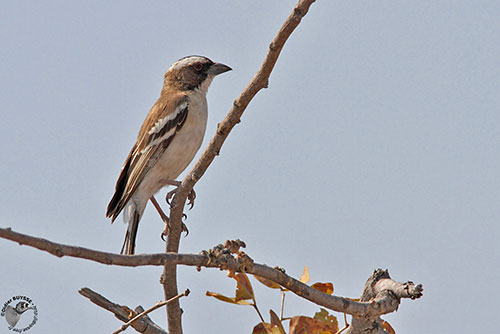
Fr: Mahali à sourcils blancs
Ang: White-browed Sparrow-Weaver
All: Weißbrauenweber
Esp: Tejedor gorrión cejiblanco
Ita: Tessitore passerino dai sopraccigli
Nd: Mahaliwever
Sd: vitbrynad sparvvävare
Photographers:
Didier Buysse
Vision d’Oiseaux
Callie de Wet
GALLERY
Jean Michel Fenerole
Photos d’Oiseaux du monde
Steve Garvie
RAINBIRDER Photo galleries
Ken Havard
My Bird Gallery & Flickr gallery 1 & Flickr gallery 2
Otto Plantema
Trips around the world
William Price
PBase-tereksandpiper & Flickr William Price
Simon Tan
PBase Bird galleries
Text by Nicole Bouglouan
Sources:
HANDBOOK OF THE BIRDS OF THE WORLD Vol 15 by Josep del Hoyo-Andrew Elliot-David Christie - Lynx Edicions – ISBN: 9788496553682
BIRDS OF AFRICA SOUTH OF THE SAHARA by Ian Sinclair and Peter Ryan - Princeton University Press Princeton and Oxford - ISBN: 0691118159
The Birds of Africa: Volume VII – C. Hilary Fry, Stuart Keith – Editeur: Bloomsbury Publishing, 2020 – ISBN: 1472986563, 9781472986566 – 724 pages
BIRDS OF SOUTHERN AFRICA – By Ian Sinclair, Phil Hockey and Warwick Tarboton – Princeton Field Guides - Princeton and Oxford – ISBN: 0-691-09682-1
ROBERTS BIRDS OF SOUTH AFRICA by G. R. Mc Lachlan and R. Liversidge – The Trustees of the John Voelcker Bird Book Fund – ISBN: 0620031182
Weaver Watch - Monitoring the Weavers of the World
SORA - Cooperative breeding behaviour in the White-browed sparrow-weaver
White-browed sparrow weaver’s breeding strategy helps it to survive under harsh conditions
Preferred habitat of white-browed sparrow-weavers Plocepasser mahali
Wikipedia, the free encyclopaedia
White-browed Sparrow-Weaver
Plocepasser mahali
Passeriformes Order – Ploceidae Family
INTRODUCTION:
The White-browed Sparrow-Weaver is a large Ploceidae with brown and white plumage, and a broad white stripe above the eye, giving the bird its name.
It is mainly found in NC Southern Africa, and beyond these limits, to Kenya and Ethiopia through several regions. It frequents semi-arid acacia and mopane woodlands. Four subspecies share the large range.
The White-browed Sparrow-Weaver feeds primarily on insects and seeds, depending on both region and season. It forages mainly on the ground.
This monogamous species performs co-operative breeding. The group includes a dominant pair and several helpers. The nest is built in tree, mainly thorny ones. Several nests are usually built and used for breeding and roosting.
The White-browed Sparrow-Weaver is described as common to abundant, and currently, the species is not globally threatened.

DESCRIPTION OF THE BIRD:
Biometrics:
Length: 17 cm
Weight: 31-59 g
The White-browed Sparrow-Weaver of nominate race has brown nape to lower mantle, whereas rump and uppertail-coverts are white. Upperwing and tail are brown. On the upperwing, conspicuous wingbars are formed by the white tips of both greater and medium wing-coverts. The flight-feathers show narrow pale edges.
The underparts are white with buffy tinge on flanks.
On the head, forehead and crown are dark brown, usually darker than upperparts. We can see a broad eyebrow, giving the bird its name. Cheeks and ear-coverts are brown and the malar stripe is blackish.
The bill is pale brown to black, probably depending on the season. The eyes are chestnut-brown to dark brown. Legs and feet are brown.
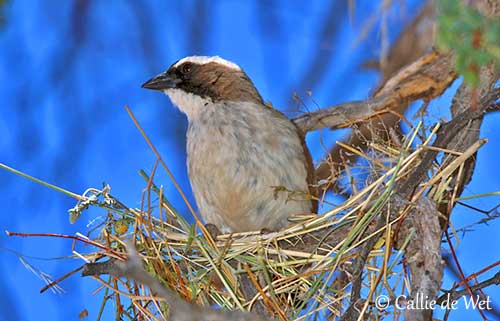
Male and female have similar plumage, but the female’s bill is mostly light grey to horn-coloured.
The juvenile resembles adults, but the bill is darker and the eyes are dull brown.
SUBSPECIES AND RANGE:
The White-browed Sparrow-Weaver has four subspecies.
P.m. melanorhynchus is found in SE South Soudan, C and E Ethiopia, SE Somalia, Uganda and Kenya.
This race has earthen-brown upperparts. The breast sides show black marks extending from the black malar stripe. The bill is black.
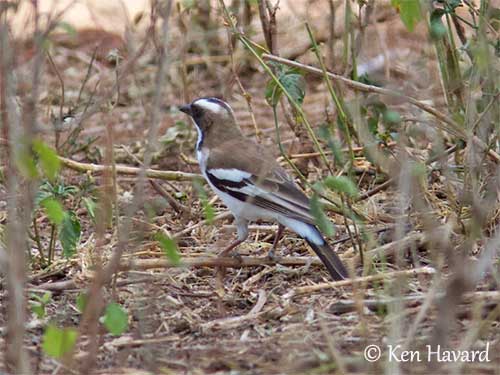
P.m. ansorgei is found in SW Angola and N Namibia.
It has broad white tips to rectrices. It is also named White-tailed Sparrow-Weaver.
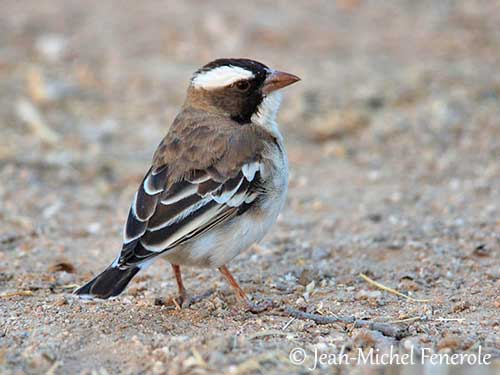
P.m. pectoralis occurs on N, C and SE Tanzania, S and E Zambia, S Malawi, W Mozambique, N Zimbabwe and N Botswana.
This one has reddish-brown mantle and back, and spotted dark breast feathers.
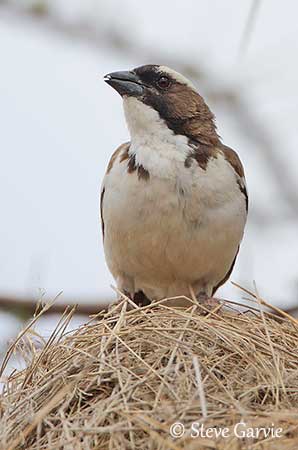
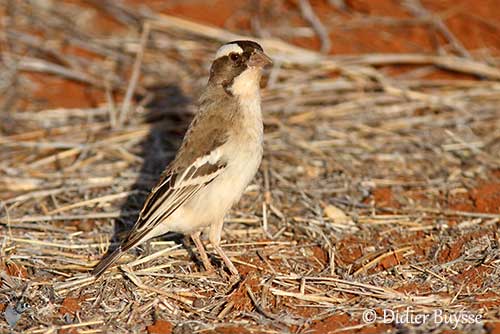
HABITAT:
The White-browed Sparrow-Weaver usually frequents mopane (Colophospernum mopane) and acacia savanna with large trees for roosting and nesting. This colonial species often nests along thornveld or around this area, especially where the thornveld adjoins open grasslands or maize fields.
CALLS AND SONGS: SOUNDS BY XENO-CANTO
The White-browed Sparrow-Weaver’s call note is a harsh “chick, chick”. The alarm call is a short “chuk”. The flight call is a shriller chirp.
The song given by the dominant male includes loud, liquid notes uttered in unbroken sequence during 6 to 20 minutes. This song is mainly heard at dawn, and shows considerable volume and attraction. No two phrases are exactly the same.
The breeding pair performs short duets lasting about 5 seconds.
The song given by the group-members is a short, stereotyped chorus used as territorial song.
These birds can be heard all year-round.
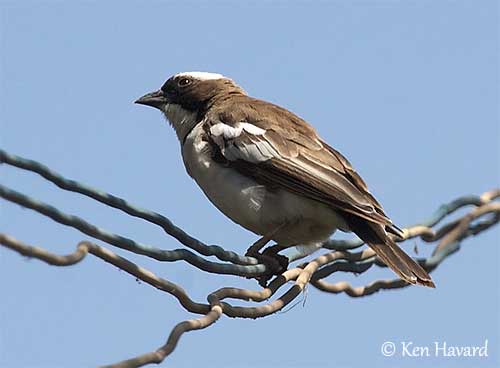
BEHAVIOUR IN THE WILD:
The White-browed Sparrow-Weaver feeds mainly on insects such as Coleopteran, Hemipteran, Orthopteran, ants and termites. It also consumes fruits, seeds and fleshy leaves. Seeds of grasses and cereals are mainly eaten in winter.
It forages mainly on the ground. It runs and hops while pursuing a prey. It also searches for food items on the underside of the vegetation, and digs in soil while moving small stones.
It may sometimes join mixed-species flocks in thorny woodland in South Africa. The diet varies both seasonally and regionally. When the temperatures are very high, they spend more time in shaded areas than in foraging territories.
This species seems to be entirely independent of water.
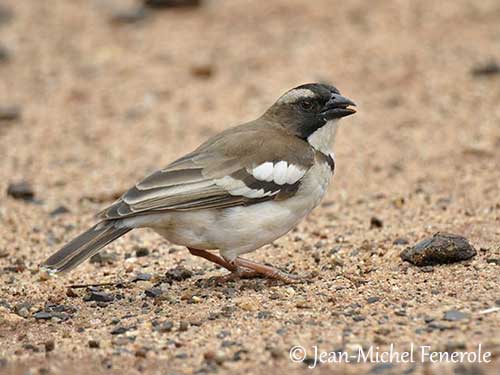
The White-browed Sparrow-Weaver is monogamous. It lives in groups and is a co-operative colonial breeder. The members of the group, usually their offspring, become helpers and are highly territorial. They defend strongly their foraging area and chase intruders out the territory which is occupied all year-round.
The dominant pair builds the nest, a tubular structure with two entrances, but one of which is closed during the nesting cycle. It is placed in thorny tree which provides protection against predators. The nests with two entrances are used for roosting.
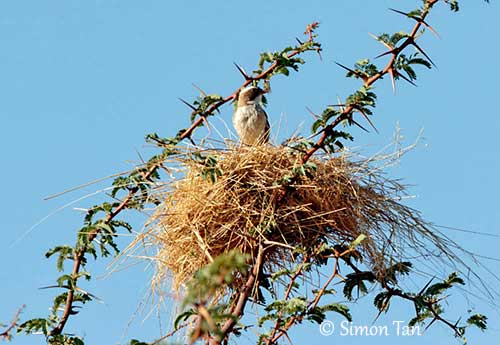
The courtship behaviour of this species is poorly known. However, an observation describes some displays, with the male giving a musical trill just before the copulation. Then, both male and female fly off together.
A second copulation was observed nine days later on the ground, under the tree where the colony was established. The male followed the female on the ground during two minutes, before the female accepts it. She did not crouch, but she pointed her closed bill straight up while her tail was held horizontal and vibrating. Then, she gave a faint, fairly melodious but somewhat strained cry.
The White-browed Sparrow-Weaver is mainly a resident species and only performs some local movements.
The flight is mainly fast and direct. In flight, the white rump is conspicuous.
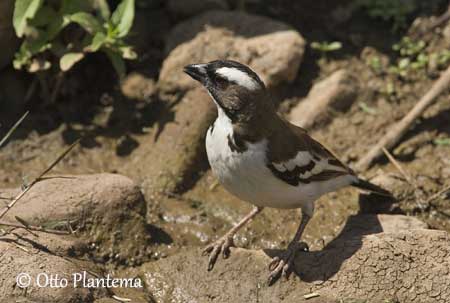
REPRODUCTION OF THIS SPECIES:
The breeding season of the White-browed Sparrow-Weaver is usually related to rainfall. The species breeds all year-round in Kenya and South Africa, depending on weather. In other regions, it breeds in March/May in E Africa, July/August in Kenya, November/December in Angola, December/March in Zambia, October/February in Malawi and May/June in Botswana.
The White-browed Sparrow-Weaver breeds in small group of 5-9 individuals, but sometimes up to 20. They perform co-operative breeding with helpers, either offspring or other birds.
Nest-building occurs throughout the year, but mainly after rain. The nest is also used for roosting. This structure resembles a horizontal cylinder made of dry grasses. It is 30 centimetres long and 18 centimetres in diameter. It is built on supporting branches and there are two entrances, one at each end. The nest-building takes 10-18 days.
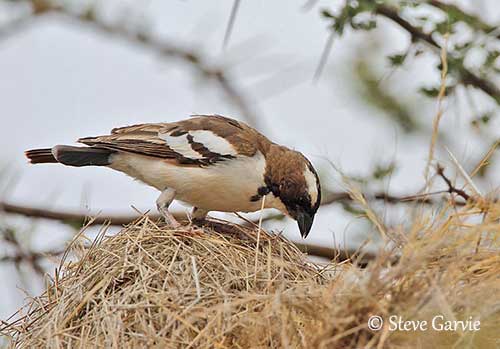
When the nesting cycle begins, the lower entrance is closed and the nest is lined with feathers (especially from Guineafowl of genus Numida). Some flowers are sometimes added.
The nest is built between 2 and 8 metres above the ground in thorny tree, mainly Mopane or Acacia, but some others can be used too.
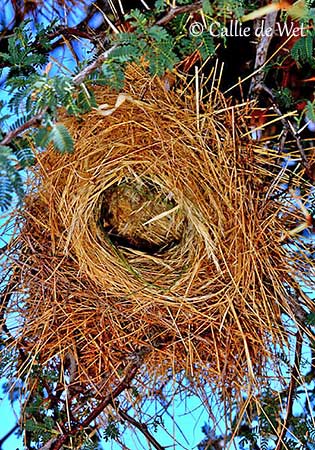
The female lays 2-3 salmon-pink or creamy-white eggs with darker markings at the larger end. She incubates alone during 14-16 days. After hatching, the chicks are fed by the female for the first 2-3 days and then, male and helpers help to feed the young.
The nestling period varies from 17-18 days in Zambia to 21-23 days in South Africa.
After fledging, the young still depend occasionally for food for up to 3 months.
The usual predators of this species are the Vervet Monkey, the Shikra and the African Harrier Hawk.
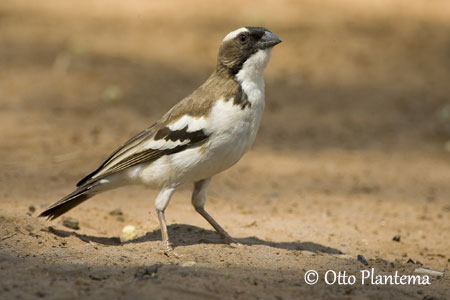
PROTECTION / THREATS / STATUS:
The White-browed Sparrow-Weaver is described as common to abundant in semi-arid regions.
The species is not globally threatened. The size of the population is unknown, but the numbers are not declining.
The White-browed Sparrow-Weaver is currently evaluated as Least Concern.
